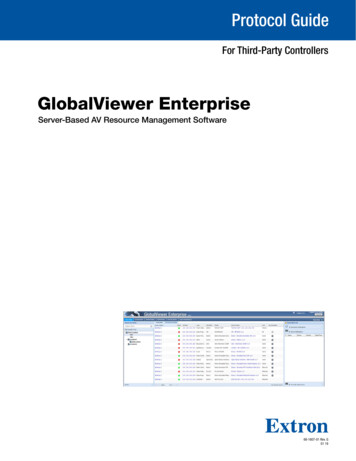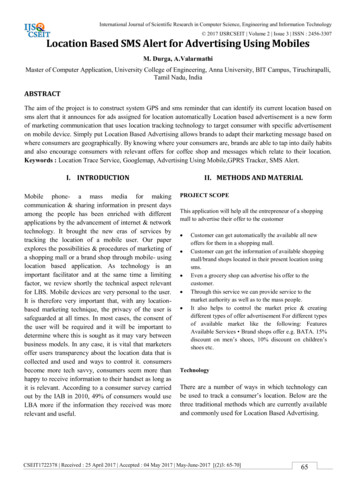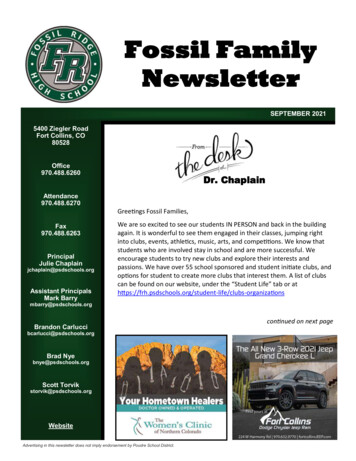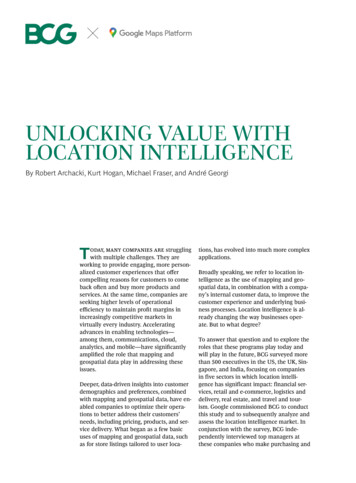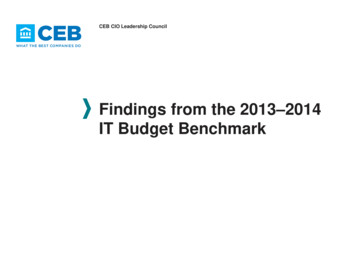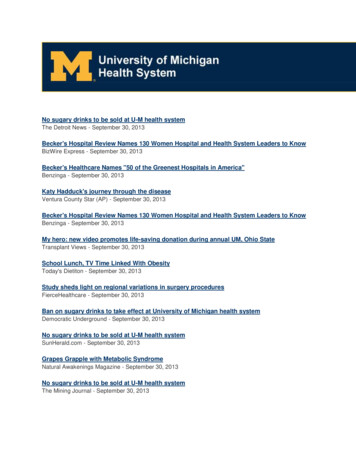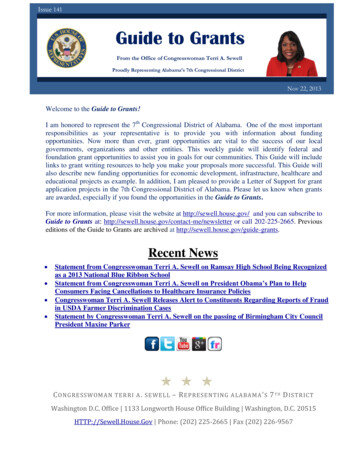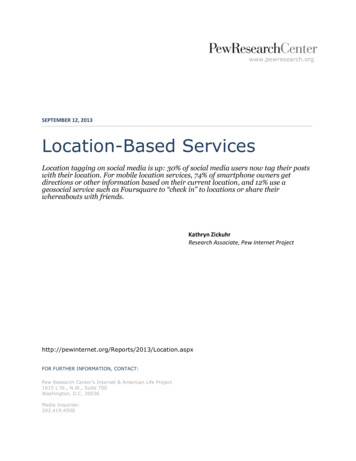
Transcription
www.pewresearch.orgSEPTEMBER 12, 2013Location-Based ServicesLocation tagging on social media is up: 30% of social media users now tag their postswith their location. For mobile location services, 74% of smartphone owners getdirections or other information based on their current location, and 12% use ageosocial service such as Foursquare to “check in” to locations or share theirwhereabouts with friends.Kathryn ZickuhrResearch Associate, Pew Internet n.aspxFOR FURTHER INFORMATION, CONTACT:Pew Research Center’s Internet & American Life Project1615 L St., N.W., Suite 700Washington, D.C. 20036Media Inquiries:202.419.4500
OverviewMain findingsThe role of location in digital life is changing as growing numbers of internet users are adding a newlayer of location information to their posts, and a majority of smartphone owners use their phones’location-based services. 1A new survey by the Pew Research Center’s Internet Project sheds light on three major aspects of howlocation figures in digital life: Many people use their smartphones to navigate the world: 74% of adult smartphone ownersages 18 and older say they use their phone to get directions or other information based ontheir current location. There is notable growth in the number of social media users who are now setting their accountsto include location in their posts. Among adult social media users ages 18 and older, 30% saythat at least one of their accounts is currently set up to include their location in their posts, upfrom 14% who said they had ever done this in 2011.2 This trend is also showing up amongyounger users. An earlier Pew Internet survey of teens ages 12-17 found that 16% of teen socialmedia users have their accounts set up to automatically include their location in posts.3 There is a modest drop in the number of smartphone owners who use “check in” locationservices. Some 12% of adult smartphone owners say they use a geosocial service to “check in”to certain locations or share their location with friends. That is down from 18% of smartphoneowners who reported doing that type of activity in early 2012. A plurality of these geosocialservice users (39%) say they check into places on Facebook; 18% say they use Foursquare and14% say they use Google Plus, among other services.Taken together, these trends show the ascent of location awareness and the role it might play in the lifeof users—and the technology companies that are scrambling to provide more alert-style applicationsthat tell people who and what is near them.Local is a bigger part of the broader social media landscape, and the rise of local services is strongly tiedto the increase in smartphone ownership. The majority of smartphone owners say they are making useof their phones’ location-based services, and the share of all adults who do this continues to grow alongwith increasing smartphone adoption.Yet even as most smartphone owners use their phones’ abilities to get location-specific information,data from earlier surveys also shows that mobile users of all ages say they have turned off locationtracking features at some point due to privacy concerns:1Our definition of a smartphone owner includes anyone who says directly that their phone is a smartphone or whosays that their phone operates on a smartphone platform common to the U.S. market (56% of all adults). For moreinformation, see: ership-2013.aspx2Change in question wording over time. See “Survey questions” at the end of this report for details.3“Social media users” are defined as online adults who use social networking sites or Twitter. As of May 2013, 72% ofinternet users use a social networking site like Facebook, and 18% use -networking-sites.aspxpewinternet.org2
As of September 2012, almost half (46%) of teen app users say they have turned off the locationtracking feature on their cell phone or in an app on a phone or tablet because they were worriedabout other people or companies being able to access that information. As of April 2012, in response to a question measuring a somewhat different behavior, over athird (35%) of adult cell app users said they have turned off the location-tracking feature ontheir cell phones.4About this surveyThe findings in this report are based on data from telephone interviews conducted by Princeton SurveyResearch Associates International from April 17 to May 19, 2013, among a sample of 2,252 adults ages18 and older. Telephone interviews were conducted in English and Spanish by landline and cell phone.For results based on the total sample, one can say with 95% confidence that the error attributable tosampling is plus or minus 2.3 percentage points. More information is available in the Methods sectionat the end of this -Privacy/Main-Findings/Section-2.aspx For more information aboutAmericans’ online privacy and anonymity practices in general, see “Anonymity, Privacy, and Security Online” (2013),available at ne.aspx.pewinternet.org3
Location-Based ServicesOverview: Location-based servicesThe rise of smartphones has brought real-time location data into many aspects of Americans’ lives.Some mobile services use the smartphone’s location to offer directions, targeted recommendations, orother location-specific information to the user. Other services incorporate a location “layer” into othertypes of functions, while still others exist specifically to share the user’s location with friends or thegeneral public.To date, our surveys have tracked two types of location-based services: those that use people’swhereabouts to provide location-targeted information such as directions or recommendations, andgeosocial services that let users “check in” to certain locations or share their location with friends.However, it is becoming increasingly difficult to delineate these two categories, as social media servicesincorporate location as an element of user activity and as location-centric services embrace varyingdegrees of social functionality.Foursquare, a geosocial service that originally focused on location-sharing and points earned through“checking in” to locations, is now beginning to de-emphasize its system of points, badges, and sociallocation-sharing.5 Instead, it is mining its previous check-in data to offer real-time location-triggeredsuggestions that incorporate friends’ and other users’ activities and recommendations. On its blog,Foursquare offered examples of the new approach, such as sending a user a note about a “can’t missdish on the menu” when she arrives at a new restaurant, or suggesting “a few places that your friendslove” in a new neighborhood or city.6Meanwhile, social media services like Facebook, Instagram, and Twitter have added an optional locationlayer (in many cases built on Foursquare’s API) so that users can show where they are when they postmaterial on the sites. And many information-focused services, from activity-tracking apps to rating sitessuch as Yelp, incorporate location-sharing and other social aspects as well.As of May 2013: Some 74% of adult smartphone owners get directions or other information based on theircurrent location. This works out to 45% of all adults. Some 12% of smartphone owners use a geosocial service such as Foursquare to “check in” tocertain locations or share their location with friends. This works out to 7% of all adults.5Vindu Goel, “With New App, Foursquare Strives to Be ‘Magic’ in Your Pocket.” New York Times, August 29, cket/6“A smarter Foursquare, so you don’t miss a thing.” Foursquare blog, August 29, .org4
Three-quarters of smartphone owners get real-time location-basedinformation, and one in eight use geosocial services% of adults within each group who use their cell phone to get directions, recommendations, orother information related to a location where they happen to be, and the % who use a geosocialservice such as Foursquare to “check in” to certain locations or share their location with friends.All adultsSmartphone ownersGet location-based directions/information45%74%Use a geosocial or “check-in” service7%12%Source: Pew Research Center’s Internet & American Life Project, April 17-May 19, 2013 TrackingSurvey of 2,252 adults ages 18 and older. Interviews were conducted in English and Spanish and onlandline and cell phones. The margin of error on the sample is /- 2.3 percentage points.Use of location-based information and geosocial servicesamong smartphone owners, 2011-2013For location services: % of smartphone owners who use their phone to get directions,recommendations, or other information related to a location where they happen to be.For geosocial services: % of smartphone owners who use a service such as Foursquare orGowalla to “check in” to certain locations or share their location with friends.74%80%74%70%60%55%Location-basedinfo 0%May 2011Feb 2012May 2013* Slight wording change since previous surveySource: Pew Research Center’s Internet & American Life Project tracking surveys. For 2011data, n 2,277 adults ages 18 and older. For 2012, n 2,253 adults. For 2013, n 2,252 adults.All surveys were conducted via landline and cell phone, in English and Spanish.pewinternet.org5
Location-based information servicesMany web services and apps incorporate a user’s location in order to offer relevant information. Forinstance, driving directions may rely on the user’s location to offer detailed turn-by-turn directions toanother location, or a to-do list app might offer “geo-fenced” alerts, such as reminding the user to buymilk when she is near a grocery store.Almost three-quarters (74%) of smartphone owners say they use their phone to get directions or otherinformation related to a location where they happen to be. This percentage has held steady in the pastyear, but the increasing popularity of smartphones means that among all adults, the proportion who saythey access location-based information has risen from 41% in 2012 to 45% in May 2013.7Most smartphone owners access location-based informationDo you ever use your cell phone to get directions or other information related to a locationwhere you happen to neowners55%41%45%All adults23%May 2011Feb 2012May 2013Note: Slight wording change.Source: Pew Research Center’s Internet & American Life Project tracking surveys conductedApril 26-May 22, 2011, January 20-February 19, 2012, and April 17-May 19, 2013. For 2011data, n 2,277 adults ages 18 and older. For 2012 data, n 2,253 adults. For 2013 data, n 2,252adults. All surveys were conducted via landline and cell phone, in English and Spanish.Smartphone users under age 50 are significantly more likely to say they get location-based directionsand information than older smartphone users, and college graduates are more likely to do this thanadults who only completed high school. There were no statistically significant differences amongsmartphone owners by gender, race or ethnicity, household income, or community type.These adoption patterns are generally similar to those we found in early 2012, though at that timewhites were also more likely to use these services than African Americans, and adults in higher-incomehouseholds were more likely to use these services than those in lower-income households.7Slight change in question wording over time. February 2012 and May 2013 question wording was “Get directions or otherinformation related to a location where you happen to be.” May 2011 question wording was “Get directions,recommendations, or other information related to your present location.”pewinternet.org6
Who uses location-based information services?% of adult smartphone owners within each group who use theirsmartphone to get directions, recommendations, or other informationrelated to a location where they happen to be, as of May 2013.% who getlocation-baseddirections &informationAll smartphone owners ages 18 (n 1,178)74%GenderMen (n 589)76b Women (n 589)Age72acda18-29 (n 326)80b30-49 (n 397)75c50-64 (n 310)65d 65 (n 118)Race/ethnicitycd58aWhite, Non-Hispanic (n 770)76bBlack, Non-Hispanic (n 152)67c Hispanic (English- and Spanish-speaking) (n 156)Education attainment73aHigh school grad or less (n 324)69bSome college (n 304)75cCollege (n 544)78aHousehold incomeaLess than 30,000/yr (n 220)70b 30,000- 49,999 (n 179)75c 50,000- 74,999 (n 172)78d 75,000 (n 435)Urbanity76aUrban (n 426)75bSuburban (n 574)72cRural (n 176)76Source: Pew Research Center’s Internet & American Life Project, April 17May 19, 2013 Tracking Survey of 2,252 adults ages 18 and older.Interviews were conducted in English and Spanish and on landline and cellphones. The margin of error on the sample is /- 2.3 percentage points.aNote: Percentages marked with a superscript letter (e.g., ) indicate astatistically significant difference between that row and the rowdesignated by that superscript letter, among categories of eachdemographic characteristic (e.g. age).pewinternet.org7
Geosocial servicesAs of May 2013, 12% of smartphone owners use geosocial services such as Foursquare to “check in” to acertain location or share their location with friends. This is down from 18% of smartphone owners inFebruary 2012. For all adults, this represents a change from 10% in 2012 to 7% in 2013.8Geosocial services over timeDo you ever use your cell phone to use a service such as Foursquare to “check in” to certainlocations or to share your location with your eownersAll adults0%May 2011Feb 2012May 2013Source: Pew Research Center’s Internet & American Life Project tracking surveys conductedApril 26-May 22, 2011, January 20-February 19, 2012, and April 17-May 19, 2013. For 2011data, n 2,277 adults ages 18 and older. For 2012 data, n 2,253 adults. For 2013 data, n 2,252adults. All surveys were conducted via landline and cell phone, in English and Spanish.There are few clear differences in geosocial use between demographic groups, though Hispanicsmartphone users are significantly more likely to use geosocial services than whites or blacks, andsuburban adults are more likely to use these services than rural adults.Finally, there were no statistically significant differences in geosocial service use among smartphoneowners by gender or educational attainment.8Slight change in question wording over time. February 2012 and May 2013 question wording was: “Use a service suchas Foursquare or Gowalla to 'check in' to certain locations or to share your location with your friends.” May 2011question wording was: “Use a service such as Foursquare or Gowalla to “check in” to certain locations or share yourlocation with friends.”pewinternet.org8
Who uses geosocial services?% of adult smartphone owners within each group who use a geosocial servicesuch as Foursquare to “check in” to certain locations or share their locationwith friends, as of May 2013.% who usegeosocial servicesAll smartphone owners ages 18 (n 1,178)12%GenderMen (n 589)11b Women (n 589)Age13aca18-29 (n 326)16b30-49 (n 397)11c50-64 (n 310)9d 65 (n 118)Race/ethnicity11aWhite, Non-Hispanic (n 770)10bBlack, Non-Hispanic (n 152)11cHispanic (English- and Spanish-speaking) (n 156)24abEducation attainmentaHigh school grad or less (n 324)14bSome college (n 304)13c College (n 544)Household income10daLess than 30,000/yr (n 220)16b 30,000- 49,999 (n 179)13c 50,000- 74,999 (n 172)18dd 75,000 (n 435)Urbanity9aUrban (n 426)10bSuburban (n 574)14cRural (n 176)c9Source: Pew Research Center’s Internet & American Life Project, April 17May 19, 2013 Tracking Survey of 2,252 adults ages 18 and older. Interviewswere conducted in English and Spanish and on landline and cell phones. Themargin of error on the sample is /- 2.3 percentage points.aNote: Percentages marked with a superscript letter (e.g., ) indicate astatistically significant difference between that row and the row designatedby that superscript letter, among categories of each demographiccharacteristic (e.g. age).pewinternet.org9
Which geosocial services people useFor the first time, we also asked users of geosocial or “check-in” services which location services theyuse. We found that a plurality of geosocial users (39%) say they use Facebook, while almost one in five(18%) say they use Foursquare, and 14% say they use Google Plus; several other services werementioned as well, such as Instagram and Yelp.What location-sharing or “check-in”services do you use?Among cell phone owners who use location services, the %who say they use each of the following services% of geosocial users(n 141)Facebook39%Foursquare18Google Plus14Google Latitude8Google Maps5Instagram5Yelp5Facebook Poke1Path1Twitter1Other21None/Don’t use any regularly4Don’t know7Refused1Source: Pew Research Center’s Internet & American LifeProject, April 17-May 19, 2013 Tracking Survey of 2,252adults ages 18 and older. Interviews were conducted inEnglish and Spanish and on landline and cell phones.Note: Total may exceed 100% due to multiple responses.pewinternet.org10
Location Tagging Among Social Media UsersAdult social media users and location taggingMany social media sites enable users to set up the service to automatically “tag” their updates on thesite with the user’s current location. Our May 2013 survey found that 30% of adult social media userssay that at least one of their accounts is currently set up to include their location in their posts, up from14% who had ever done this in 2011.9Social media users under age 50 are the age group most likely to tag their location on social networkingsites, and those living in suburban areas are more likely to say they do this than those living in ruralareas. Among social media users, there were no significant differences by gender, education level, orhousehold income.The demographics of social media users with automatic location-tagging have changed since we lastasked about this activity in May 2011. At that time, we found that men, African Americans andHispanics, adults in households earning less than 30,000 per year, and those who have not gone tocollege were significantly more likely than other social media users to use automatic location-tagging,and there were no significant differences between different age groups.109Change in question wording over time. May 2013 question wording was: “Thinking about how you use socialnetworking sites. are any of your social networking accounts currently set up so that they include your location onyour posts?” February 2012 question wording was: “Thinking about the ways people might use social networkingsites. Do you ever set up your account so that it automatically includes your location on your posts?” In May 2011,question was asked as an item in a list question with the following question wording: “Thinking about the ways peoplemight use social networking sites. Do you ever. Set up your account so that it automatically includes your locationon your posts?”10More: “28% of American adults use mobile and social location-based services” n.aspxpewinternet.org11
Location tagging among adult social media users% of social media users ages 18 within each group whose social mediaaccounts that are currently set up to include their location on their posts, asof May 2013% who tag locationin social postsAll social media users ages 18 (n 683)30%GenderaMen (n 319)30bWomen (n 364)30a18-29 (n 185)32b30-49 (n 233)34c50-64 (n 171)26d65 (n 81)18AgeddEducation attainmentaHigh school grad or less (n 213)31bSome college (n 183)31cCollege (n 280)29Household incomeaLess than 30,000/yr (n 155)32b 30,000- 49,999 (n 125)26c 50,000- 74,999 (n 96)33d 75,000 (n 203)36UrbanityaUrban (n 246)28bSuburban (n 308)35cRural (n 129)24cSource: Pew Research Center’s Internet & American Life Project, April 17May 19, 2013 Tracking Survey of 2,252 adults ages 18 and older. Interviewswere conducted in English and Spanish and on landline and cell phones.aNote: Percentages marked with a superscript letter (e.g., ) indicate astatistically significant difference between that row and the row designatedby that superscript letter, among categories of each demographiccharacteristic (e.g. age). The sample size in this case was too small to breakdown differences by race/ethnicity.pewinternet.org12
Teen social media users and location taggingPrevious surveys have also asked teens ages 12-17 about their social media practices, including locationtagging. Our recent report on how teens share personal information and manage privacy settings onsocial media, “Teens, Social Media, and Privacy,” found that 16% of teen social media users said they setup their profile or account so that it automatically includes their location in posts.11Boys and girls and teens of all ages and socioeconomic backgrounds are equally likely to say that theyhave set up their profile to include their location when they post. However, teen social media usersliving in suburban areas are significantly more likely to say they tag their location on social networkingsites than teens living in rural or urban areas, as shown in the chart below.Focus group data suggests that many teens find sharing their location unnecessary and unsafe, whileothers appreciate the opportunity to signal their location to friends and parents.11“Teens, Social Media, and Privacy” (2013): edia-AndPrivacy.aspxpewinternet.org13
Location tagging among teen social media users% of teen social media users ages 12-17 within each group who say they set uptheir profile or account so that it automatically includes their location in posts,as of September 2012% who tag locationin social postsAll teen social media users ages 12-17 (n 632)16%Teen genderaBoys (n 308)17bGirls (n 324)16Age of teena12-13 (n 151)15b14-17 (n 481)17Parent race/ethnicityaWhite, Non-Hispanic (n 437)15bBlack, Non-Hispanic (n 95)22Parent’s education attainmentaHigh school grad or less (n 187)18bSome college (n 157)18cCollege (n 285)14Parent’s household incomeaLess than 50,000/yr (n 121)21b 50,000 (n 266)13UrbanityaUrban (n 457)11bSuburban (n 628)21cRural (n 239)11aSource: Pew Internet July 26-September 30, 2012 Parent/Teen Privacy Surveyof 802 teens ages 12-17. Interviews were conducted in English and Spanishand on landline and cell phones.aNote: Percentages marked with a superscript letter (e.g., ) indicate astatistically significant difference between that row and the row designated bythat superscript letter, among categories of each demographic characteristic(e.g. age). There are no statistically significant differences between any ofthese subgroups except between suburban and urban teens.pewinternet.org14
Turning Off Location-Tracking FeaturesOver a third of adult cell app users have turned off the location-tracking feature on theircell phonesEven as most smartphone owners use their phones’ geolocation abilities to get location-specificinformation, data from earlier surveys also shows that many mobile users of all ages say they haveturned off location-tracking features at some point due to privacy concerns.12Among adult cell phone users ages 18 and older who have downloaded apps to their cell phone, 35%have turned off the location tracking feature on their phone at some point because they were worriedabout other people or companies being able to access that information. This works out to 19% of adultcell phone owners overall as of April 2012.13 For more information on cell phone owners’ activities, seeour 2012 report “Privacy and Data Management on Mobile Devices.”Almost half of teen cell or tablet app users have turned off the location-tracking feature ontheir cell phone or in an appIn a different report exploring teens’ mobile privacy practices, we asked teen app users ages 12-17 asimilar but differently worded question. We found that as of September 2012, almost half (46%) of teenapp users say they have turned off the location tracking feature on their cell phone or in an app becausethey were worried about other people or companies being able to access that information.Yet as our earlier report on teens and mobile app privacy noted, some of the people those teens areconcerned about may be their own parents. As early as 2009, the Pew Internet Project found that abouthalf of parents of teen cell phone owners said they used the phone to monitor their child’s location insome way.14Girls are significantly more likely than boys to say they have turned off location-tracking features,though there are no differences between younger and older teens. There are also no differences in thelikelihood that a teen apps user will disable a location tracking feature according to household income,parent’s education level, or race and ethnicity (not shown in the chart below).1512A separate study in July 2013 found that 54% of internet users said it was “very important” that only they and thosethey had authorized should have access to their location when they use the internet. For more information, tion-2.aspx14This parental location monitoring could take many forms—including the use of calling, texting or GPS to keep track ofa child’s location. The question wording did not specify what tools parents had l-phone-use.aspx15Focus group participants understood that apps can access various data on their smartphones and tablets, such astheir pictures, contacts, or location. In many cases, they reported that they did not allow an app to access theirlocation, unless they thought it was necessary. -Privacy.aspxpewinternet.org15
Almost half of teen app downloaders have turned offlocation-tracking features% of teen app downloaders ages 12-17 within each group who say they have turnedoff the location tracking feature on their cell phone or in an app because they wereworried about other people or companies being able to access that information% turned offlocation featuresAll teen app downloaders ages 12-17 (n 489)46%Teen genderaBoys (n 253)37bGirls (n 236)59aAge of teena12-13 (n 151)46b14-17 (n 481)47Source: Pew Internet July 26-September 30, 2012 Parent/Teen Privacy Survey of 802teens ages 12-17. Interviews were conducted in English and Spanish and on landlineand cell phones.aNote: Percentages marked with a superscript letter (e.g., ) indicate a statisticallysignificant difference between that row and the row designated by that superscriptletter, among categories of each demographic characteristic (e.g. gender).pewinternet.org16
Survey QuestionsFinal ToplineSpring 2013 Tracking Survey5/21/2013Data for April 17-May 19, 2013Princeton Survey Research Associates International forthe Pew Research Center’s Internet & American Life ProjectSample: n 2,252 national adults, age 18 and older, including 1,127 cell phone interviewsInterviewing dates: 04.17.2013 – ononononTotal [n 2,252]all internet users [n 1,895]all cell phone owners [n 2,076]all SNS or Twitter users [n ononFormFormFormFormA internet users [n 970]B internet users [n 925]A SNS or Twitter users [n 683]B SNS or Twitter users [n 642]Do you use the internet, at least occasionally?EMLOCC Do you send or receive email, at least occasionally?EMINUSE Do you use the internet or email, at least occasionally?INTMOBDo you access the internet on a cell phone, tablet or other mobile handheld device, atleast occasionally?16INTUSECurrentDecember 201217September 2012August 201218April 2012February 2012USES INTERNETDOES NOT USEINTERNET85818185828015191915182016The definition of an internet user varies from survey to survey. In the current survey, half the sample was askedINTUSE/EMLOCC/INTMOB and half was asked EMINUSE/INTMOB. Current results are for both forms combined. Throughoutthe current topline, total internet users are defined as those who answered yes to any question INTUSE, EMLOCC, EMINUSEor INTMOB. From April 2012 thru December 2012, an internet user is someone who uses the internet at least occasionally,sends/receives email at least occasionally or accesses the internet a mobile device (three-part definition with questionwording “Do you use the internet, at least occasionally?” OR “Do you send or receive email, at least occasionally?” OR “Doyou access the internet on a cell phone, tablet or other mobile handheld device, at least occasionally?”). From January 2005thru February 2012, an internet user is someone who uses the internet at least occasionally or sends/receives email at leastoccasionally (two-part definition with question wording “Do you use the internet, at least occasionally?” OR “Do you send orreceive email, at least occasionally?”).17December 2012 trends based on the 2012 Post-Election Tracking Survey, conduct
Some mobile services use the smartphone's location to offer directions, targeted recommendations, or other location-specific information to the user. Other services incorporate a location "layer" into other types of functions, while still others exist specifically to share the user's location with friends or the general public.
